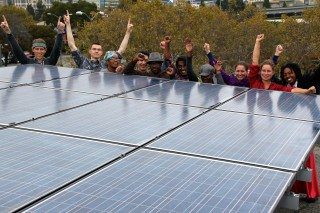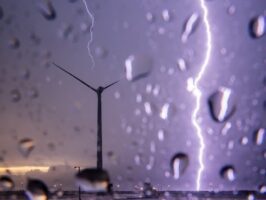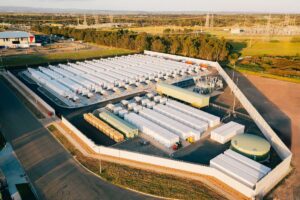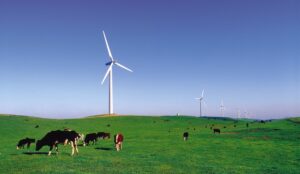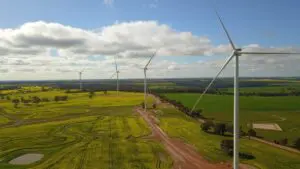The Andrew Forrest-owned renewable energy developer Squadron Energy to set up a fund to allow members of the local community to invest in two wind farms in central New South Wales (NSW), copying a shared ownership structure that it inherited from the Sapphire wind farm.
A newly established fund will be open only to people living in the Central-West Orana Renewable Energy Zone (REZ), the home of the 414 megawatt (MW) Uungula (now under construction) and proposed 700 MW Spicers Creek wind projects
The buy-in is for a minimum of $1000 and a maximum of $20,000, with a promise of 7 per cent annual returns for ten years, after which the investor receives their capital back.
ASX-listed DomaCom, a company that specialises in fractional ownership, is handling the fund, after rolling out a similar facility for the Sapphire wind farm in 2019.
The Orana fund will require a $1 million minimum to get up and a maximum of $5 million; it opened last week to investors and will include future Squadron Energy projects in the REZ.
The Orana REZ offer is similar to the Sapphire version, in that investors are loaning money to the projects, but the interest rate is slightly higher at 7 per cent instead of 6 per cent, says DomaCom executive director Ross Laidlaw.
“We do offer investors a secondary market where they can attempt to trade their units in the fund, to another buyer [online],” he says.
Squadron Energy inherited the unusual combined ownership structure when it bought CWP Renewables in 2022, which included the 270 MW Sapphire project and $1.8 million of community funds from approximately 100 investors, managed by DomaCom.
The company did not respond to requests for comment about what benefits the Sapphire structure provided, in the past and today, and why they are encouraging it to continue with the experiment.
In a statement, Squadron Energy chairman Jason Willoughby said the Orana REZ program was designed to create benefits for the community, and that the Sapphire fund rollout was successful.
The company broke ground on the Uungula wind farm in February, the largest commercial wind farm to be built in NSW to date.
Shared ownership has been tried in Australia
Australians have few direct options for investing in renewable energy – the last remaining renewables and storage company on the ASX is Genex Power and that is likely to be taken over by Japanese company J-Power.
But shared ownership of renewables projects has been trialled in Australia before now. The five-turbine Coonooer Bridge wind farm in Victoria combined corporate and community ownership between developer Windlab and 30 landowners within 3km of the wind farm.
Two other small wind farms, Hepburn Wind in Victoria and Denmark in WA, were also built with a combined ownership structure, but communities are usually left out of very large projects.
OSMI, the developer of the contested Delburn wind farm in Gippsland, Victoria, says it will also offer community co-investment.
But aside from Indigenous groups, which have been able to negotiate different ownership structures as a bloc such as the Sunshine Hydro project in Queensland or traditional owners of Yindjibarndi lands in Western Australia’s Pilbara region, developers haven’t been keen to test the experiment – even in the face of rising community opposition to projects.
Legislation in 2021 proposed by MP for Indi, Helen Haines, that would require 20 per cent of all renewables projects be offered to local residents did not get across the line.
Indeed, Haines said newly re-installed leader of the Nationals Party, Barnaby Joyce, told her he was interested in setting up a dedicated federal agency to support community energy projects.
Ownership gives individuals a reason to support
The lack of shared ownership over the renewable energy projects popping up across the countryside is irking community groups, which want to see more mutual benefits like this being opened up to locals, and criticised by academics who say it will empower Australias.
Yet research is proving the obvious: communities with a financial stake in renewable energy projects – onshore wind farms, in this study – are more likely to support them.
Squadron’s Spicers Creek project is feeling the barbs of local opposition, with the AFR late last year then the ABC in February running interviews with neighbours annoyed by secrecy clauses in compensation payments for neighbours.
Squadron is offering to kick in an extra $2000 per household for investors who live within 8km of the two wind farms.
Not simple
Offering communities ownership in projects in the area comes with complexities, a fact admitted by German developer RES Group, which regularly offers individuals the opportunity to buy in to European projects, and the International Renewable Energy Agency (IRENA).
IRENA says a successful community owned model will include two of three elements: a structure that gives anything from full to minority ownership to locals, a decision-making say in the project, and the local distribution of benefits such as financial returns or jobs.
IRENA says government support in the form of grants, loans, microcredit, tax incentives and subsidies can help give community investors confidence.

